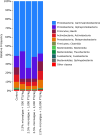Microalgae and phytase dietary supplementation improved growth and gut microbiota in juvenile European seabass (Dicentrarchus labrax)
- PMID: 39242559
- PMCID: PMC11378478
- DOI: 10.1186/s12864-024-10760-x
Microalgae and phytase dietary supplementation improved growth and gut microbiota in juvenile European seabass (Dicentrarchus labrax)
Abstract
Fishmeal and fish oil have been the main sources of protein and fatty acid for aquaculture fish. However, their increasing price and low sustainability have led the aquafeed industry to seek sustainable alternative feedstuffs to meet the nutritional requirements of fish and improve their health and performance. Plant proteins have been successfully used to replace fishery derivatives in aquafeeds, but the presence of anti-nutritional substances is a potential drawback of this approach. Thus, it has been reported that phytate breakdown can be caused by feed supplementation with exogenous phytase. The inclusion of microalgae has been proposed to improve gut functionality in fish fed diets with a high vegetable protein content. The aim of this study was to evaluate the effect on the growth and gut microbiota of European seabass (Dicentrarchus labrax) juveniles of a diet containing a blend of microalgae (Arthrospira platensis and Nannochloropsis gaditana) and different concentrations of phytase. An 83-day feeding trial was conducted, comprising four experimental diets with 2.5% microalgae and 500, 1,000, 2,000, or 10,000 phytase units (FTU)/kg feed and a microalgae- and phytase-free control diet. At the end of the trial, a significantly increased body weight was observed in fish fed the diet with the highest phytase concentration (10,000 FTU/kg) versus controls, although the gut bacterial composition did not differ from controls in alpha or beta diversity with either majority (Weighted UniFrac) or minority bacterial strains (Unweighted UniFrac). In comparison to the control group, the groups fed diets with 1,000 or 2,000 FTU/kg diets had a lower alpha diversity (Shannon's diversity index), while those fed diets with 500 FTU/kg or 1,000 FTU/kg showed distinct clusters in beta diversity (involving minority ASVs). According to these findings, the diet containing the 2.5% microalgae blend with 10,000 FTU/kg may be useful to increase the aquafeed quality and sustain the growth performance of juvenile European seabass.
Keywords: Arthrospira platensis; Dicentrarchus labrax; Nannochloropsis Gaditana; Fish nutrition; Gut microbiota; Microalgae; Phytase.
© 2024. The Author(s).
Conflict of interest statement
The authors declare no competing interests.
All authors declare no conflict of interest.
Figures




References
-
- Camacho-Rodríguez J, Macías-Sánchez MD, Cerón-García MC, Alarcón FJ, Molina-Grima E. Microalgae as a potential ingredient for partial fish meal replacement in aquafeeds: nutrient stability under different storage conditions. J Appl Phycol. 2018;30:1049–59.10.1007/s10811-017-1281-5 - DOI
-
- Ghamkhar R, Hicks A. Comparative environmental impact assessment of aquafeed production: sustainability implications of forage fish meal and oil free diets. Resour Conserv Recycl. 2020;161:104849.10.1016/j.resconrec.2020.104849 - DOI
-
- Rabelo-Ruiz M, Peralta-Sánchez JM, Martín-Platero AM, Ruiz AJ, Agraso MM, Bermúdez L, Ariza JJ, Baños A, Valdivia E, Martínez-Bueno M. Allium-derived compound propyl propane thiosulfonate (PTSO) reduces Vibrio populations and increases body weight of European seabass (Dicentrarchus labrax) juveniles. Antibiot Chemother. 2023;12:134.10.3390/antibiotics12010134 - DOI - PMC - PubMed
-
- Galafat A, Vizcaíno AJ, Sáez MI, Gómez-Pinchetti JL, Acién FG, Martínez TF, Alarcón FJ. Evaluation of the in vitro protein bioaccessibility of several microalgae and Cyanobacteria as potential dietary ingredients in gilthead seabream (Sparus aurata) juveniles. J Appl Phycol. 2022;34:2075–88.10.1007/s10811-022-02764-5 - DOI
-
- Bandara T. Alternative feed ingredients in aquaculture: opportunities and challenges. J Entomol Zool. 2018;6:3087–94.
MeSH terms
Substances
Grants and funding
- RYC2022-036147-I/Ministerio de Ciencia, Innovación y Universidades
- 6127/Programa Operativo de Empleo Juvenil , Fondo Social Europeo, Junta de Andalucia
- ALQUABIOTIC ITC-20181099/FEDER INNTERCONECTA 2018
- ALQUABIOTIC ITC-20181099/FEDER INNTERCONECTA 2018
- ALQUABIOTIC ITC-20181099/FEDER INNTERCONECTA 2018
LinkOut - more resources
Full Text Sources
Medical

